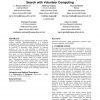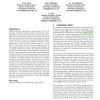HPDC
2010
IEEE
14 years 6 months ago
2010
IEEE
Cloud computing is increasingly considered as an additional computational resource platform for scientific workflows. The cloud offers opportunity to scale-out applications from d...
HPDC
2010
IEEE
14 years 6 months ago
2010
IEEE
Grid computing has been widely adopted for intensive high performance computing. Since grid resources are distributed over complex large-scale infrastructures, understanding grid ...
HPDC
2010
IEEE
14 years 6 months ago
2010
IEEE
As the number of cores inside compute clusters continues to grow, the scalability of MPI (Message Passing Interface) is important to ensure that programs can continue to execute o...
HPDC
2010
IEEE
14 years 6 months ago
2010
IEEE
Sequence comparison is considered as a cornerstone application in bioinformatics, which forms the basis of many other applications. In particular, pairwise sequence alignment is a...
HPDC
2010
IEEE
14 years 6 months ago
2010
IEEE
Automated analysis of unstructured text documents (e.g., web pages, newswire articles, research publications, business reports) is a key capability for solving important problems ...
HPDC
2010
IEEE
14 years 6 months ago
2010
IEEE
HPDC
2010
IEEE
14 years 6 months ago
2010
IEEE
MapReduce offers a flexible programming model for processing and generating large data sets on dedicated resources, where only a small fraction of such resources are every unavaila...
HPDC
2010
IEEE
14 years 6 months ago
2010
IEEE
This paper proposes a comprehensive modeling architecture for workloads on parallel computers using Markov chains in combination with state dependent empirical distribution functi...
HPDC
2010
IEEE
14 years 6 months ago
2010
IEEE
Modern scientific collaborations have opened up the opportunity of solving complex problems that involve multidisciplinary expertise and large-scale computational experiments. The...
HPDC
2010
IEEE
14 years 6 months ago
2010
IEEE
Large scale bioinformatics experiments are usually composed by a set of data flows generated by a chain of activities (programs or services) that may be modeled as scientific work...





